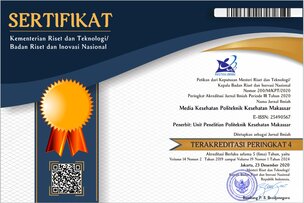GAMBARAN KUALITAS TIDUR PADA PENDERITA HIPERTENSI QUALITY OF SLEEP AMONG HYPERTENSION PATIENTS
Abstract
People with hypertension experience symptoms of dizziness, headache, obstructive sleep apnea, shortness of breath, nocturia, and restless legs syndrome which disturb sleep and reduce its quality. This research’s objective was to describe the sleep quality overview of Puskesmas Rancaekek’s hypertension patients. Using descriptive quantitative method with purposive sampling technique, this research aimed at 79 Puskesmas Rancaekek’s patients who had been diagnosed with hypertension for at least one month long. The data were collected using the Pittsburgh Sleep Quality Index (PSQI) questionnaire and analysed using the total score resulted; ≤5 was good while >5 was poor. Results showed 94.6% of respondents had poor sleep quality. The dimensions that contribute to the poor sleep quality included >30 minutes sleep latency, <5 hours sleep duration, <65% of sleep efficiency, sleep disturbance due to waking up at midnight or early morning and waking up to toilet, and activity disturbance at daylight. The conclusion was that Puskesmas need to develop preventive and promotive efforts to minimize the complication of hypertension patients and optimize their quality of life by helping them improve their quality of sleep. Meanwhile, the self-management that should be done by the patients were avoiding the consumption of coffee and cigarettes, limiting physical activities, and doing physical exercise and relaxation therapies.
Key Words: Hypertension, Sleep Quality, PSQI
Abstrak
Penderita hipertensi mengalami gejala pusing, nyeri kepala, obstructive sleep apnea, sesak napas, nokturia, restless legs syndrome yang mengganggu tidur dan berdampak pada kualitas tidur serta mempengaruhi kualitas hidup dan tekanan darah. Penelitian bertujuan untuk melihat gambaran kualitas tidur pada penderita hipertensi di Puskesmas Rancaekek. Metode penelitian menggunakan deskriptif kuantitatif dengan teknik purposive sampling sebanyak 79 penderita hipertensi di Puskesmas Rancaekek yang telah didiagnosis dokter minimal 1 bulan. Pengambilan data menggunakan kuesioner Pittsburgh Sleep Quality Index (PSQI) dan dianalisis menggunakan total skor, jika skor ≤ 5 baik dan skor > 5 buruk. Hasil menunjukan 94,6% responden memiliki kualitas tidur buruk. Dimensi yang berkontribusi terhadap kualitas tidur buruk yaitu latensi tidur tidak dapat tertidur dalam waktu 30 menit, durasi tidur <5 jam, efisiensi kebiasaan tidur <65%, gangguan tidur karena terbangun tengah malam atau pagi sekali dan terbangun karena ingin ke toilet, serta gangguan aktivitas pada siang hari. Puskesmas perlu mengembangkan upaya preventif dan promotif untuk meminimalisir komplikasi penderita hipertensi dan pencapaian kualitas hidup optimal salah satunya dengan membantu meningkatkan kualitas tidur. Dengan mengedukasi penderita untuk menghindari konsumsi kopi dan rokok, membatasi aktivitas fisik, melakukan latihan fisik, dan terapi relaksasi.
Kata Kunci: Hipertensi, Kualitas Tidur, PSQI
Keywords
Full Text:
PDF (Bahasa Indonesia)References
Black & Hawks. (2014). Keperawatan Medikal Bedah: Manajemen Klinis Untuk Hasil yang Diharapkan. In 2 (8th ed.). Singapore: Elsevier.
Buysse, D. J., Reynolds, C. F., Monk, T. H., Berman, S. R., Kupfer, D. J., III, C. F. R., … Kupfer, D. J. (1989). The Pittsburgh Sleep Quality Index: a new instrument for psychiatric practice and research. Psychiatry Research, 28(2), 193–213. https://doi.org/10.1016/0165-1781(89)90047-4
Dinkes. (2017). Laporan PTM Puskesmas. Kabupaten Bandung.
Gunawijaya, F. . (2011). Manfaat Penggunaan Antihistamin Generasi Ketiga. Kedokteran Trisakti, 2, 123–129. Retrieved from http://www.univmed.org/wp-content/uploads/2011/02/anthistamin.pdf
Hairunnisa. (2014). Hubungan Tingkat Kepatuhan minum Obat dan Diet dengan Tekanan Darah Terkontrol Pada penderita Hipertensi lansia di wilayah Kerja Puskesmas Perumnas I Kecamatan Pontianak Barat. Fakultas Kedokteran, Universitas Tanjungpura, Pontianak, 25. https://doi.org/10.1017/CBO9781107415324.004
Hanus, J. S., Amboni, G., da Rosa, M. I., Ceretta, L. B., & Tuon, L. (2015). The quality and characteristics of sleep of hypertensive patients. Revista Da Escola de Enfermagem, 49(4), 594–599. https://doi.org/10.1590/S0080-623420150000400009
Harfiantoko, M. N., & Kurnia, E. (2013). Derajat Hipertensi (Menurut Who) Mempengaruhi Kualitas Tidur dan Stress Psikososial Mirza Nursyamsu Harfiantoko, Erlin Kurnia. Jurnal STIKES, Vol. 6 No.
Hartzell, K., Avis, K., Lozano, D., & Feig, D. (2016). Obstructive sleep apnea and periodic limb movement disorder in a population of children with hypertension and/or nocturnal nondipping blood pressures. Journal of the American Society of Hypertension, 10(2), 101–107. https://doi.org/10.1016/j.jash.2015.11.010
Kartikasari, A. N. (2012). Faktor Risiko Hipertensi pada Masyarakat di Desa Kabongan Kidul, Kabupaten Rembang, 1–26.
Kemenkes RI. (2014). Pusdatin Hipertensi. Infodatin, (Hipertensi), 1–7. https://doi.org/10.1177/109019817400200403
Khasanah, K., & Hidayati, W. (2012). Kualitas Tidur Lansia Balai Rehabilitasi Sosial “ mandiri ” Semarang. Jurnal Nursing Studies, 1(1), 189–196. Retrieved from http://ejournal-s1.undip.ac.id/index.php/jnursing
Kline, C. E. (2014). The Bidirectional Relationship Between Exercise and Sleep: Implications for Exercise Adherence and Sleep Improvement. American Journal of Lifestyle Medicine, 8(6), 375–379. https://doi.org/10.1177/1559827614544437
Kozier & Berman. (2010). Buku Ajar Fundamental Keperawatan: Konsep, Proses, & Praktik (7th ed.). Jakarta: EGC.
Lionakis, N., Mendrinos, D., Sanidas, E., Favatas, G., & Georgopoulou, M. (2012). Hypertension in the elderly. World Journal of Cardiology, 4(5), 135. https://doi.org/10.4330/wjc.v4.i5.135
Liu, P., & Zheng, J. G. (2017). Blood pressure targets in the hypertensive elderly. Chinese Medical Journal, 130(16), 1968–1972. https://doi.org/10.4103/0366-6999.211885
Lo, K., Woo, B., Martin, B. N., & Wilson, W. (2018). Subjective sleep quality , blood pressure , and hypertension : a meta- analysis, (December 2017), 592–605. https://doi.org/10.1111/jch.13220
Lubis, D. P. (2013). Kualitas tidur dan faktor-faktor gangguan tidur pada penderita hipertensi di Wilayah Kerja Puskesmas Medan Teladan.
Mansoor, G. A. (2002). Sleep actigraphy in hypertensive patients with the “non-dipper” blood pressure profile. Journal of Human Hypertension, 16(4), 237–242. https://doi.org/10.1038/sj/jhh/1001383
Nuraini, B. (2015). Risk factors of hypertension. J Majority, 4(5), 10–19.
Ogeil, R. P., & Phillips, J. G. (2015). Commonly used stimulants: Sleep problems, dependence and psychological distress. Drug and Alcohol Dependence, 153, 145–151. https://doi.org/10.1016/j.drugalcdep.2015.05.036
Potter & Perry. (2010). Fundamental Keperawatan. In 3 (7th ed.). Singapore: Elsevier.
Puskesmas Rancaekek. (2017). Laporan Tahunan. Bandung.
Putra, F. S. (2016). Pengaruh pemberian ranitidin terhadap gambara histopatologi gaster tikus wistar pada pemberian metanol dosis bertingkat, 5(4), 8–9.
Riskesdas. (2013). Badan Penelitian dan Pengembangan Kesehatan. Laporan Nasional 2013, 1–384. https://doi.org/1 Desember 2013
Sagala, V. P. (2011). Kualitas Tidur dan Faktor-Faktor Gangguan Tidur pada Penderita Hipertensi di Wilayah Kerja Puskesmas Medan Johor.
Sari, W. Y. (2017). Gambaran kualitas lansia dengan hipertensi di desa rancaekek wetan kabupaten bandung dan kelurahan maleber kota bandung.
Setyaningsih, R. D., Dewi, P., & Suandika, M. (2014). Studi Prevalensi dan Kajian Faktor Risiko Hipertensi pada Lansia di Desa Tambaksari Banyumas.
Utami, P. (2009). Solusi Sehat Mengatasi Hipertensi (1st ed.). Jakarta: Agromedia Pustaka.
Wennman, H., Kronholm, E., Partonen, T., Tolvanen, A., Peltonen, M., & Vasankari, T. (2014). Physical activity and sleep profiles in Finnish men and women. BMC Public Health, 14(1), 1–10. https://doi.org/10.1186/1471-2458-14-82
Wu, E.-L., Chien, I.-C., & Lin, C.-H. (2014). Increased risk of hypertension in patients with anxiety disorders: A population-based study. Journal of Psychosomatic Research, 77(6), 522–527. https://doi.org/10.1016/j.jpsychores.2014.10.006
Xianlong X, Yunshaang R, & Zumin S. (2016). Hypertension Impact on Health-Related Quality of Life: A Cross-Sectional Survey among Middle-Aged Adults in Chongping China`. Internation Jounrnal of Hypertension, 2016, 1–7.
Zheng, L.-W., Chen, Y., Chen, F., Zhang, P., & Wu, L.-F. (2014). Effect of acupressure on blood pressure and sleep quality of middle-aged and elderly patients with hypertension. International Journal of Nursing Sciences, 1(4), 334–338. https://doi.org/10.1016/j.ijnss.2014.10.012
DOI: https://doi.org/10.32382/medkes.v13i2.663
Refbacks
- There are currently no refbacks.
Copyright (c) 2018 Media Kesehatan Politeknik Kesehatan Makassar
Published By : Poltekkes Kemenkes Makassar
Office : Jl. Wijaya Kusuma Raya No. 46 Banta-Bantaeng, Kota Makassar, Sulawesi Selatan, Indonesia
Email : mediakesehatan@poltekkes-mks.ac.id
Media Kesehatan indexed by :
Protected By  |  |

This work is licensed under a Creative Commons Attribution-NonCommercial-ShareAlike 4.0 International License.




